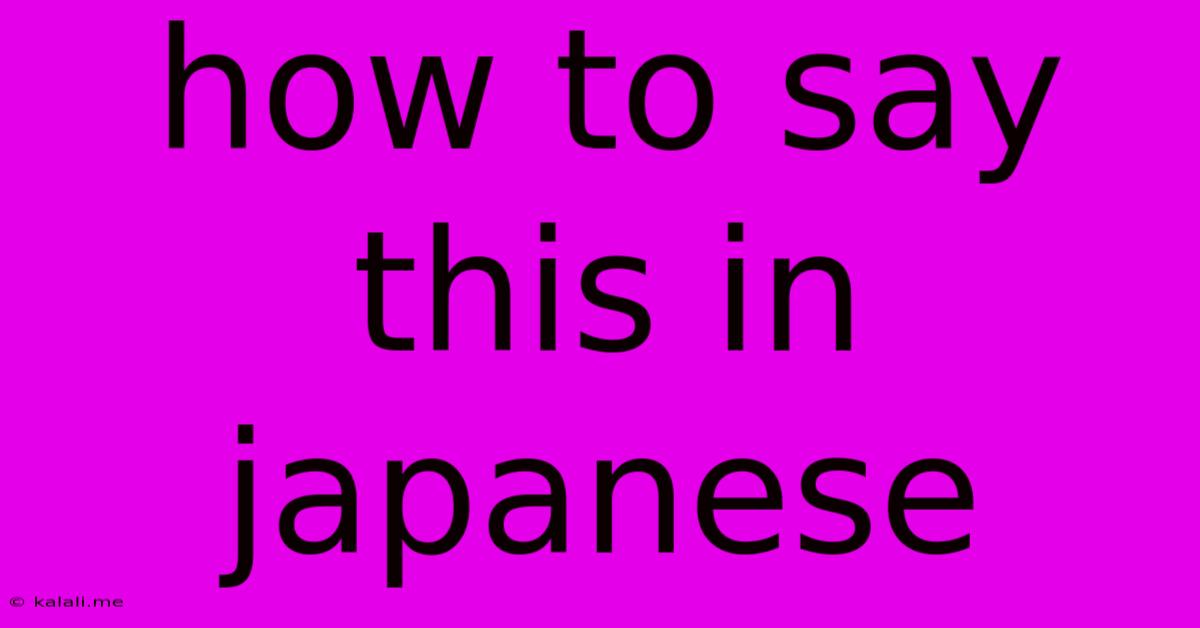How To Say This In Japanese
Kalali
Jun 02, 2025 · 3 min read

Table of Contents
How to Say "This" in Japanese: A Comprehensive Guide
Knowing how to say "this" in Japanese is fundamental to mastering the language. However, the translation isn't as straightforward as it seems in English, as the best choice depends heavily on context. This article will delve into the nuances of expressing "this" in Japanese, equipping you with the knowledge to choose the perfect word every time. This guide covers various situations and provides examples to solidify your understanding.
Understanding the Nuances of "This"
Unlike English, Japanese doesn't have a single word for "this" that fits all situations. The appropriate word depends on several factors, including:
- The object's proximity: Is "this" something near the speaker, the listener, or somewhere else?
- The object's nature: Is it a thing, a person, or an action?
- The level of formality: Are you speaking to a friend, a superior, or a stranger?
Key Words for Expressing "This"
Here are some of the most common ways to say "this" in Japanese, along with their uses and examples:
1. これ (kore): This (near the speaker)
This is the most basic and commonly used word for "this" when referring to something close to the speaker.
- Example: これ、私のペンです。(Kore, watashi no pen desu.) This is my pen.
2. これら (korera): These (plural, near the speaker)
The plural form of "kore," used when referring to multiple things close to the speaker.
- Example: これら、リンゴです。(Korera, ringo desu.) These are apples.
3. それ (sore): That (near the listener)
Use "sore" when referring to something close to the listener but not the speaker.
- Example: それ、あなたの本ですか?(Sore, anata no hon desu ka?) Is that your book?
4. それら (sorera): Those (plural, near the listener)
The plural form of "sore," used for multiple things near the listener.
- Example: それら、美しい花ですね。(Sorera, utsukushii hana desu ne.) Those are beautiful flowers.
5. あれ (are): That (far from both speaker and listener)
Use "are" when referring to something distant from both the speaker and the listener.
- Example: あれ、富士山ですか?(Are, Fujisan desu ka?) Is that Mount Fuji?
6. あれら (arera): Those (plural, far from both speaker and listener)
The plural form of "are," used for multiple things far from both the speaker and the listener.
- Example: あれら、雲ですね。(Arera, kumo desu ne.) Those are clouds.
7. この (kono): This (before a noun)
This is a demonstrative adjective used before a noun to mean "this."
- Example: この本 (kono hon) This book
8. その (sono): That (before a noun, near the listener)
This demonstrative adjective is used before a noun to indicate "that" near the listener.
- Example: その犬 (sono inu) That dog
9. あの (ano): That (before a noun, far from both)
This demonstrative adjective is used before a noun for "that" which is far away from both the speaker and listener.
- Example: あの建物 (ano tatemono) That building
Choosing the Right Word: Context is Key
Remember, the correct word depends entirely on the context. Pay attention to the location of the object relative to you and the person you're speaking to. Practice using these words in different sentences to solidify your understanding. Mastering these nuances will significantly improve your Japanese communication skills. Consistent practice and immersion will help you naturally select the appropriate word in any given situation.
Latest Posts
Latest Posts
-
How Does English Sound To Foreigners
Jun 03, 2025
-
What Is The Complement Of A False Positive
Jun 03, 2025
-
How Long Does It Take For Oil To Heat Up
Jun 03, 2025
-
What Does He Say In Dune
Jun 03, 2025
-
Can A Witness Refuse Questions In Court
Jun 03, 2025
Related Post
Thank you for visiting our website which covers about How To Say This In Japanese . We hope the information provided has been useful to you. Feel free to contact us if you have any questions or need further assistance. See you next time and don't miss to bookmark.